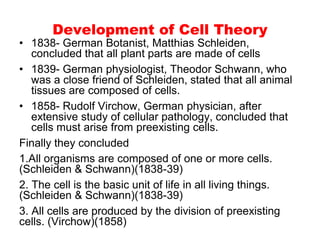
Cell Theory.pptx
- 1. Development of Cell Theory • 1838- German Botanist, Matthias Schleiden, concluded that all plant parts are made of cells • 1839- German physiologist, Theodor Schwann, who was a close friend of Schleiden, stated that all animal tissues are composed of cells. • 1858- Rudolf Virchow, German physician, after extensive study of cellular pathology, concluded that cells must arise from preexisting cells. Finally they concluded 1.All organisms are composed of one or more cells. (Schleiden & Schwann)(1838-39) 2. The cell is the basic unit of life in all living things. (Schleiden & Schwann)(1838-39) 3. All cells are produced by the division of preexisting cells. (Virchow)(1858)
- 2. Cell theory Cell theory states that living things are composed of one or more cells, that the cell is the basic unit of life, and that cells arise from existing cells. The cell theory describes the basic properties of all cells. • The three scientists that contributed to the development of cell theory are Matthias Schleiden, Theodor Schwann, and Rudolf Virchow. • A component of the cell theory is that all living things are composed of one or more cells. • A component of the cell theory is that the cell is the basic unit of life. • A component of the cell theory is that all new cells arise from existing cells.
- 4. Modern Cell Theory Modern Cell Theory contains 4 statements, in addition to the original Cell Theory: • The cell contains hereditary information(DNA) which is passed on from cell to cell during cell division. • All cells are basically the same in chemical composition and metabolic activities. • All basic chemical & physiological functions are carried out inside the cells.(movement, digestion, etc) • Cell activity depends on the activities of sub-cellular structures within the cell(organelles, nucleus, plasma membrane) • Cell are classified as Unicellular and Multicellular
- 5. Endosymbiotic Theory • In 1831, Scottish botanist Robert Brown (1773–1858) was the first to describe observations of nuclei, which he observed in plant cells. • Then, in the early 1880s, German botanist Andreas Schimper (1856–1901) was the first to describe the chloroplasts of plant cells, identifying their role in starch formation during photosynthesis and they divided independent of the nucleus. • Based upon the chloroplasts’ ability to reproduce independently, Russian botanist Konstantin Mereschkowski (1855–1921) suggested in 1905 that chloroplasts may have originated from ancestral photosynthetic bacteria living symbiotically inside a eukaryotic cell. He proposed a similar origin for the nucleus of plant cells. • This was the first articulation of the endosymbiotic hypothesis, and would explain how eukaryotic cells evolved from ancestral bacteria.
- 6. • Lynn Margulis (1938–2011), an American geneticist, published her ideas regarding the endosymbiotic hypothesis of the origins of mitochondria and chloroplasts in 1967. • In the decade leading up to her publication, advances in microscopy had allowed scientists to differentiate prokaryotic cells from eukaryotic cells. • The eukaryotic organelles such as mitochondria and chloroplasts are of prokaryotic origin. • This hypothesis was not initially popular, but mounting genetic evidence due to the advent of DNA sequencing supported the endosymbiotic theory. • Additionally, mitochondrial and chloroplast ribosomes are structurally similar to bacterial ribosomes, rather than to the eukaryotic ribosomes of their hosts.
- 8. Unicellular organism Organisms consisting of only one cell carry out all functions of life in that cell. • Movement • Reproduction • Sensitivity • Homeostasis • Growth • Respiration • Excretion • Nutrition The functions are refined: • Metabolism - the web of all the enzyme- catalysed reactions in a cell or organism, e.g. respiration • Response - Living things can respond to and interact with the environment • Homeostasis - The maintenance and regulation of internal cell conditions, e.g. water and pH • Growth - Living things can grow or change size / shape • Excretion – the removal of metabolic waste • Reproduction - Living things produce offspring, either sexually or asexually • Nutrition – feeding by either the synthesis of organic molecules (e.g. photosynthesis) or the absorption of organic matter
- 9. Investigation of functions of life in Paramecium and one named photosynthetic unicellular organism
- 10. Investigation of functions of life in Paramecium and one named photosynthetic unicellular organism
- 11. Multicellular organisms have properties that emerge from the interaction of their cellular components • Emergent properties arise from the interaction of component parts. • The whole is greater than the sum of its parts. • Multicellular organisms are capable of completing functions that individual cells could not undertake - this is due to the interaction between cells producing new functions. • Biology uses inductive thinking as it is realised the importance of emergent properties, whether it be the interaction of genes, enzymes working together in a metabolic pathway, or cells forming tissues, different tissues forming organs, in turn forming organ systems and then the organism itself. • At each level emergent properties arise.
- 12. Multicellular organisms have properties that emerge from the interaction of their cellular components